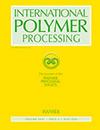蛇草纤维增强环氧复合材料的力学和摩擦学性能:爪哇梅子填料重量分数的影响
IF 1.1
4区 工程技术
Q4 ENGINEERING, CHEMICAL
引用次数: 1
摘要
摘要天然纤维复合材料在强度重量比要求较高的场合能够与普通合成材料相竞争。在本研究中,我们的目的是分析随机取向蛇草天然纤维与爪哇梅子填料制成的复合材料的力学、摩擦学和表面形貌。选择不同重量比例的纤维与种子填料:30:0,28:2,26:4,24:6,22:8,20:10。70% %的环氧树脂在所有组成中保持恒定。按照ASTM标准对制备的混杂复合材料试样进行拉伸、弯曲、剪切、邵氏硬度、吸水率和磨损试验,并与蛇草单纤维复合材料进行对比。20:10复合材料与其他复合材料相比,具有最大的拉伸强度,抗冲击性,抗弯强度,硬度,吸水性和耐磨性。利用扫描电子显微镜(SEM)研究了纤维/基质的粘附性。20:10的复合材料表现出突出的机械和摩擦学特性,使其更容易在结构和汽车应用中使用。本文章由计算机程序翻译,如有差异,请以英文原文为准。
Mechanical and tribological properties of snake grass fibers reinforced epoxy composites: effect of Java plum seed filler weight fraction
Abstract Natural fiber composite materials are able to compete with common synthetic materials in situations where the strength-to-weight ratio is important. In this study, we aim to analyze the mechanical, tribological, and surface morphology of composites fabricated from randomly oriented snake grass natural fiber with java plum seed filler. Different weight ratios of fiber to seed filler are chosen: 30:0, 28:2, 26:4, 24:6, 22:8, and 20:10. A 70 % epoxy resin was kept constant in all compositions. The fabricated hybrid composite samples were subjected to tensile, flexural, shear, Shore D hardness, water absorption, and wear tests as per ASTM standards, and the results were compared with those of snake grass mono fiber composites. The 20:10 composite has the maximum tensile strength, impact resistance, flexural strength, hardness, water absorption, and wear resistance compared to other composites. The fiber/matrix adhesion was explored using a scanning electron microscope (SEM). The 20:10 composite shows predominant mechanical and tribological characteristics, making it easier to utilize in structural and automotive applications.
求助全文
通过发布文献求助,成功后即可免费获取论文全文。
去求助
来源期刊

International Polymer Processing
工程技术-高分子科学
CiteScore
2.20
自引率
7.70%
发文量
62
审稿时长
6 months
期刊介绍:
International Polymer Processing offers original research contributions, invited review papers and recent technological developments in processing thermoplastics, thermosets, elastomers and fibers as well as polymer reaction engineering. For more than 25 years International Polymer Processing, the journal of the Polymer Processing Society, provides strictly peer-reviewed, high-quality articles and rapid communications from the leading experts around the world.
 求助内容:
求助内容: 应助结果提醒方式:
应助结果提醒方式:


